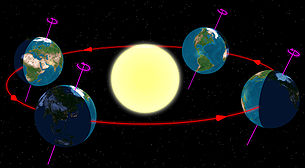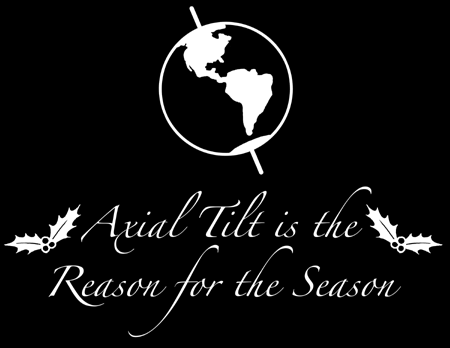![]() The Earth’s axis has a 23.44o obliquity or tilt to it. As the Earth revolves around the Sun over the course of a year, the axial tilt means that different parts of the Earth’s surface receive direct sunlight at different times of the year. And it’s this receipt of varying intensities of solar radiation that drives temperature differences, and hence seasonality.
The Earth’s axis has a 23.44o obliquity or tilt to it. As the Earth revolves around the Sun over the course of a year, the axial tilt means that different parts of the Earth’s surface receive direct sunlight at different times of the year. And it’s this receipt of varying intensities of solar radiation that drives temperature differences, and hence seasonality.
Today is a solstice, illustrated by the image on the far right below. Today is the day of the year when the Northern Hemisphere is tilted farthest away from the sun and the Southern Hemisphere is tilted most towards the sun. For those of us in the Northern Hemisphere, it’s our shortest day of the year and the sun never gets very high in the sky, even at noon. In fact, the word solstice has a Latin origin in the word solstitium, where “sol” means sun and “stitium” means stoppage. and for several days around the solstice this noontime elevation appears to be the same – hence the stoppage. Today, the noontime sun appears directly overhead along the Tropic of Capricorn, 23.44o S.

Figure 1. Earth at the solstices and equinoxes, as seen from the north. Source: Wikimedia.
The precise moment of the solstice occurs at 17:47 UTC (12:47 pm Eastern Standard Time). We’ll have another solstice (image on far left) on 21 June 2010 at 11:28 UTC ( 7:28 am Eastern Daylight Time). Over the course of the Earth’s trip around the Sun there will be two moments when everybody is getting their fair share of sunlight – the equinoxes. In 2010, they’ll occur on 20 March 2010 at 17:32 UTC and 23 September 3:09 UTC (22 September 11:09 pm EDT).
Earth’s tilt also varies over geologic time. It has a ~41-thousand year cycle, and right now we’re at about the middle of the range in variation of axial tilt. As tilt increases, seasonal contrasts over much of the world increase, but it is decreased axial tilt is tied with the onset of continental glaciation. That’s because at high latitudes, when tilt is low, summers are even cooler, and more snow persists through the summer. That surviving snow forms the nucleus of glacial ice caps. We’re currently on the decreasing limb of the obliquity cycle, but based on past occurrence of continental glaciations, the onset of another one is going to require not just less obliquity, but also the right eccentricty and precession in the Earth’s orbital parameters and controlling greenhouse gas emissions.

Figure 2: Last seen at Clastic Detritus in 2007, original created by Slumbering Lungfish.
Nice plan for content warnings on Mastodon and the Fediverse. Now you need a Mastodon/Fediverse button on this blog.



Comments (7)